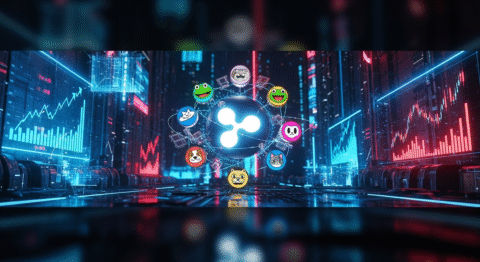lippage Tolerance 3 Secrets for Altcoin Gains
Did you know that a staggering 60% of retail investor accounts lose money when trading cryptocurrencies, often due to unseen execution factors? In the volatile world of altcoins, where fortunes can be made and lost in minutes, understanding every trading lever is crucial. Many traders overlook a seemingly small, yet incredibly impactful, setting: Slippage Tolerance. This isn’t just a technical term; it’s your first line of defense against diminished profits and can be the secret sauce to unlocking significant altcoin gains. Navigating the complexities of digital assets requires more than just picking winners; it demands mastering the mechanics of their exchange.
Crypto Market Overview: A Rollercoaster of Opportunity
The cryptocurrency market, a landscape known for its electrifying pace and unpredictable swings, is currently a fascinating tapestry of innovation and speculation. Altcoins, the cryptocurrencies that emerged after Bitcoin, continue to capture the imagination of investors, often promising disruptive technologies and higher potential returns – though with commensurate risk. We’ve witnessed significant surges in specific altcoin categories, driven by technological advancements, ecosystem growth, and even the playful allure of meme coins.
The meme coin sector, in particular, has demonstrated an astonishing capacity for rapid price appreciation, fueled by social media trends and community enthusiasm. While often dismissed as purely speculative, the underlying mechanisms that allow for their explosive growth also highlight the critical importance of efficient trade execution. Recent market data suggests a sustained interest in altcoins with strong utility, such as those powering decentralized finance (DeFi) applications or offering innovative solutions in areas like gaming and supply chain management.
Airdrops, a popular method for distributing new tokens, continue to be a significant event in the crypto space, often bringing new users into the ecosystem and creating buzz around emerging projects. Tracking these trends is vital for any serious investor, as they often precede significant market movements. Understanding these dynamics is not just about identifying where the next big wave might be, but also about ensuring your trading strategy can capitalize on it without being eroded by minor execution discrepancies.

The Core Concept: How Slippage Tolerance Actually Works
To truly master altcoin trading, we need to delve into the mechanics that govern how your trades are executed. At its heart, every transaction in the crypto space involves an agreement between a buyer and a seller at a specific price. However, in a dynamic market, the price you see when you initiate a trade might not be the exact price at which it’s ultimately filled. This is where slippage tolerance comes into play.
What Are Altcoins / Meme Coins / Airdrops?
Let’s break down these terms to establish a foundational understanding.
Altcoins: Short for “alternative coins,” altcoins are any cryptocurrencies other than Bitcoin. They represent a vast and diverse ecosystem, each with its own unique technology, use case, and community. Examples range from established players like Ethereum (ETH), which powers smart contracts and decentralized applications, to newer projects focusing on areas like privacy, interoperability, or specific industry solutions. Altcoins often aim to improve upon Bitcoin’s design or offer functionalities that Bitcoin does not.
Meme Coins: These cryptocurrencies are typically born from internet memes, jokes, or social media trends. While they often lack the underlying technological innovation of many altcoins, their value can skyrocket due to intense community support, viral marketing, and speculative interest. Dogecoin (DOGE) and Shiba Inu (SHIB) are prime examples, demonstrating how cultural phenomena can translate into significant market capitalization. The trading of meme coins often involves very short timeframes and high volatility, making Meme Coin Slippage a particularly critical factor to manage.
Airdrops: An airdrop is a promotional strategy used by cryptocurrency projects to distribute tokens freely to a wider audience. This is often done to generate awareness, attract new users, or reward existing holders of a particular cryptocurrency. Participants might receive free tokens for holding a specific coin, performing a simple task (like following a social media account), or signing up for a service. Airdrops can be a way to acquire new digital assets with minimal upfront cost, but careful attention to the project’s legitimacy is paramount.
Key Components & Technologies
The technological underpinnings of these digital assets are as varied as their use cases.
Blockchain Technology: At the foundation of most cryptocurrencies lies blockchain, a decentralized, distributed ledger technology that records transactions across many computers. This ensures transparency, security, and immutability. Different blockchains offer varying features, such as faster transaction speeds, lower fees, or enhanced privacy.
Smart Contracts: Platforms like Ethereum pioneered smart contracts – self-executing contracts with the terms of the agreement directly written into code. These contracts automatically execute when predefined conditions are met, powering decentralized applications (dApps), DeFi protocols, and the creation of new tokens, including those used in airdrops.
Decentralized Finance (DeFi): DeFi is a rapidly growing sector that aims to recreate traditional financial services (lending, borrowing, trading) using blockchain technology, cutting out intermediaries like banks. Many altcoins are integral to DeFi ecosystems, serving as governance tokens, utility tokens, or collateral within these platforms.
Tokenomics: This refers to the economic design of a cryptocurrency, encompassing its supply, distribution, and utility. Well-designed tokenomics can foster sustainable growth and value, while poorly designed ones can lead to inflation or lack of demand.
Understanding these components is crucial because they influence the liquidity and volatility associated with a particular asset, directly impacting how slippage tolerance should be set.
The Data-Driven Perspective: Quantifying the Impact
The abstract concept of slippage tolerance becomes tangible when we examine market data and the principles of tokenomics. Ignoring it is akin to leaving money on the table, especially in fast-moving altcoin markets.
Market Data & Trends
Data from various trading platforms consistently shows that during periods of high volatility or low liquidity, slippage can significantly deviate from the expected price. For instance, a study analyzing trades on decentralized exchanges (DEXs) during major market events revealed that slippage on less popular altcoins could exceed 5-10%, effectively reducing the realized profit or increasing the potential loss.
Consider the trading activity around a newly launched altcoin with a relatively small market cap and trading volume. When a significant buy order is placed, it can quickly outstrip the available sell orders at the displayed price. Without adequate slippage tolerance, the trade might fail entirely. With a generous allowance, the trade will execute, but at a less favorable price than initially anticipated.
Liquidity: Market data indicates that altcoins with higher trading volumes and a larger number of trading pairs tend to have lower slippage. This is because there are more buyers and sellers actively participating, making it easier to match orders at or near the desired price. Low-liquidity tokens are prime candidates for experiencing substantial slippage.
Volatility: During periods of sharp price movements, the gap between the quoted price and the execution price widens due to rapid shifts in supply and demand. This is where setting an appropriate slippage tolerance becomes non-negotiable. Analyzing historical volatility data for specific altcoins can help in setting a justified tolerance level.
Tokenomics & Market Health
Tokenomics plays a pivotal role in determining how susceptible an altcoin is to slippage and how much tolerance you might need.
Supply and Demand: A fixed or deflationary token supply, combined with increasing demand for the underlying project, generally leads to price appreciation. However, if demand spikes suddenly, and the circulating supply is limited, slippage can become significant during rapid buying. Conversely, a large, inflationary supply with low demand can result in low liquidity, leading to high slippage even for small trades.
Distribution: A token that is heavily concentrated in a few wallets (whales) can lead to large price swings and significant slippage. When a whale decides to buy or sell, their actions can dramatically alter the price for everyone else. Analyzing the token distribution and identifying potential whale activity is a proactive approach to anticipating slippage.
Utility and Adoption: Altcoins with strong utility and growing adoption tend to have healthier trading environments with better liquidity. This is because more users are interacting with the token for its intended purpose, leading to more balanced trading volumes. Projects with a clear roadmap and tangible use cases are generally less prone to extreme slippage than those fueled solely by hype.
For example, if an altcoin has a total supply of 1 billion tokens, and only 200 million are actively circulating, the available liquidity for trading is limited. A large buy order could consume a significant portion of the available buy orders, forcing the price up rapidly and resulting in slippage. Understanding these tokenomic factors allows you to anticipate when higher slippage tolerance might be necessary, or when a tighter tolerance could be employed to protect your gains.
Risks, Challenges & Competition
While the allure of altcoin gains is strong, navigating the landscape of digital assets comes with inherent risks and challenges that even the best slippage tolerance settings cannot entirely negate.
Risks of Altcoins and Meme Coins
Volatility: This is perhaps the most significant risk. Altcoins, especially meme coins, can experience price swings of hundreds or even thousands of percent in short periods. This extreme volatility means prices can plummet as quickly as they rise, leading to substantial losses.
Security Vulnerabilities: Newer or less established altcoins may have underlying smart contract code that is not as rigorously audited as more mature projects. This can expose them to exploits, hacks, and rug pulls, where developers abandon a project and abscond with investor funds.
Regulatory Uncertainty: The regulatory landscape for cryptocurrencies is still evolving globally. New regulations or crackdowns can significantly impact the value and legality of certain altcoins, introducing an element of unpredictability.
Lack of Utility or Adoption: Many altcoins are created with grand promises but may fail to gain traction or develop real-world utility. Without adoption, their value is purely speculative and highly susceptible to market sentiment.
Market Manipulation: Due to lower liquidity and smaller market capitalizations, many altcoins are more vulnerable to market manipulation, such as “pump and dump” schemes, where coordinated efforts artificially inflate the price before a mass sell-off.
How Does Slippage Tolerance Stack Up Against Competitors?
When we talk about “competitors” in the context of slippage tolerance, we’re often referring to the different ways trading platforms and protocols handle transaction execution. The concept itself isn’t a “competitor” but rather a crucial setting. However, the implementation and management of how it interacts with market execution strategies can be observed. Here’s a comparison of how different approaches might impact your trading, particularly concerning altcoins:
| Feature/Platform Type | Average Slippage Impact | Best Use Case | Considerations |
|---|---|---|---|
| Centralized Exchanges (CEXs) | Generally Lower (due to order books) | High-frequency trading, large volume trades, stable markets | Tend to have fixed slippage settings or limited adjustment; can also have “phantom liquidity” issues. |
| Decentralized Exchanges (DEXs) with AMMs | Variable (depends on liquidity pool depth and trade size) | Trading smaller cap altcoins, meme coins, early-stage projects | Requires active setting of slippage tolerance; can experience significant slippage on illiquid pairs. |
| DEXs with Limit Orders/Order Books | Closer to CEXs (if liquidity is sufficient) | Trading moderately liquid altcoins, seeking specific price execution | Dependent on the DEX’s design and the liquidity available in its order books. |
| Automated Trading Bots (with slippage management) | Configurable (can be optimized) | Active traders, those seeking to automate optimal entry/exit points | Requires careful configuration and understanding of the bot’s algorithms; misconfiguration can exacerbate slippage. |
The core challenge remains: in any market where prices fluctuate rapidly, especially with less liquid assets like many altcoins and meme coins, there’s a constant tension between ensuring your trade executes and getting the best possible price. Slippage tolerance is your tool to navigate this, but understanding the underlying execution mechanism of the platform you’re using is vital. For instance, a DEX using an Automated Market Maker (AMM) will inherently have different slippage characteristics than a CEX using a traditional order book.
The Future Outlook: What’s Next for Altcoins / Meme Coins / Airdrops?
The trajectory of altcoins, meme coins, and airdrops is intrinsically linked to broader blockchain innovation and market sentiment. Several key trends suggest a dynamic future:
What’s Next for Altcoins / Meme Coins / Airdrops?
Increased Utility and Real-World Adoption: As the blockchain space matures, there’s a growing emphasis on altcoins that offer tangible utility beyond speculative trading. Projects focused on DeFi, NFTs, metaverse development, gaming (GameFi), and enterprise solutions are likely to see continued development and adoption, driving demand and potentially stabilizing their value propositions.
Regulatory Clarity: As more countries develop clear regulatory frameworks for cryptocurrencies, this could usher in an era of greater institutional investment and mainstream adoption. This clarity might also lead to better protection for investors, though it could also mean stricter controls on certain types of projects, especially those found to be overly speculative or lacking robust fundamentals.
Layer-2 Solutions and Scalability: Ongoing development in Layer-2 scaling solutions for blockchains like Ethereum aims to reduce transaction fees and increase transaction speeds. This will make trading on DEXs and interacting with dApps more accessible and affordable, potentially democratizing access to a wider range of altcoins and reducing the friction that might indirectly exacerbate slippage issues on high-fee networks.
Maturation of Meme Coins: While the speculative fervor around meme coins may continue, some projects are starting to explore utility-driven models, aiming to transcend their meme origins. Future meme coins that can build strong communities, offer unique tokenomics, or integrate with broader ecosystems might see more sustainable growth, though the high-risk, high-reward nature of the sector will likely persist.
Sophisticated Airdrop Strategies: As the crypto space evolves, airdrop mechanisms are likely to become more sophisticated, potentially targeting specific user behaviors, community contributions, or loyalty programs. This could lead to more targeted and valuable airdrop distributions, requiring participants to be even more strategic in their engagement.
For traders, this means that while the potential for significant gains remains, understanding the fundamentals of each project and actively managing trading mechanics like slippage tolerance will be more critical than ever. Staying informed about technological advancements, regulatory shifts, and the evolving utility of various digital assets will be key to capitalizing on future opportunities.
Conclusion
Mastering the art of altcoin trading involves a keen understanding of both market dynamics and the granular details of execution. We’ve explored how setting an appropriate Slippage Tolerance isn’t just a technical setting; it’s a strategic tool that can directly impact your profitability. By understanding the volatility of altcoins and meme coins, analyzing tokenomics, and being aware of the risks, you can leverage slippage tolerance to your advantage. From protecting your gains to ensuring your trades execute at acceptable price points, this seemingly small setting holds considerable power.
What are your go-to strategies for managing slippage when trading altcoins? Do you have any memorable experiences, positive or negative, with slippage? Share your thoughts in the comments below! We’re always looking to explore more about the crypto market. For more insights on navigating the volatile world of digital assets, be sure to subscribe to our newsletter for updates on the latest strategies, market analyses, and expert tips.
FAQs
1. What is the ideal slippage tolerance for altcoins?
The ideal slippage tolerance for altcoins varies greatly depending on the specific coin’s liquidity, volatility, and the overall market conditions. For highly liquid altcoins on major exchanges, a tolerance of 0.5% to 1% might be sufficient. However, for lower-liquidity altcoins or during periods of high market volatility, you might need to set it higher, perhaps 1.5% to 5% or even more, to ensure your trade executes. It’s a balancing act between allowing the trade to fill and accepting too much price deviation.
2. How does slippage affect meme coins specifically?
Meme coins, due to their often speculative nature, extreme volatility, and sometimes lower liquidity, are particularly susceptible to significant slippage. Rapid price pumps are common, and if you’re trying to buy into a surge or sell during a peak, the price can move against you very quickly between the moment you initiate the trade and when it’s executed on the blockchain. This makes managing meme coin slippage a critical component of trading them.
3. Should I set my slippage tolerance higher for airdrop tokens?
When trading newly distributed airdrop tokens, it’s often advisable to set a cautiously higher slippage tolerance. This is because these tokens may have low initial liquidity and experience rapid price discovery as the market reacts to their launch. A higher tolerance increases the likelihood that your initial sell or buy order will be filled, though you should always be mindful of how much price movement you are willing to accept.
4. How does slippage tolerance work on different types of exchanges (CEX vs. DEX)?
On Centralized Exchanges (CEXs), slippage might be less of a user-configurable setting, with the exchange’s matching engine managing execution. However, they still experience slippage internally. On Decentralized Exchanges (DEXs) utilizing Automated Market Makers (AMMs), users typically set a specific percentage slippage tolerance within their wallet or the trading interface. This directly dictates the maximum acceptable price difference for a trade to be confirmed by the smart contract.
5. Can I lose money if I set my slippage tolerance too high?
Yes, setting your slippage tolerance too high can lead to losses. If you set it extremely high, your trade will execute even if the price moves significantly against you. For example, if you set a 10% slippage tolerance to buy a token at $1, your order could still fill at $1.10, even if the market quickly corrects back down to $1.05. It’s crucial to use a tolerance level that reflects the typical volatility and liquidity of the asset, not just the maximum possible deviation.






